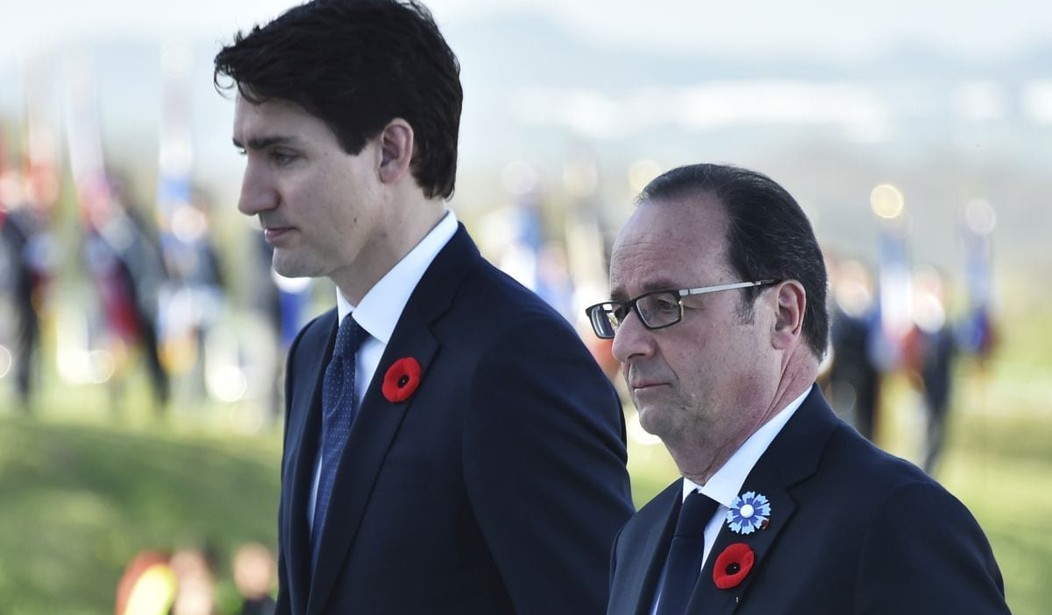One hundred years ago today, April 9, 1917, the Battle of Vimy Ridge began — a day being remembered by millions of Canadians as an event that many believe made our neighbors to the north one nation.
It was the first time that Canada’s four divisions fought side by side as a country. Canada had received its independence from Great Britain only 50 years before and the battle proved to be a rallying point for the entire nation.
On those blood-soaked slopes, about 3600 Canadian soldiers lost their lives. Farm boys from Calgary, fishermen from Nova Scotia, laborers from Toronto, policemen from Montreal — Canadians from every walk of life and every province made the ultimate sacrifice to help win the war.
Prime Minister Justin Trudeau made the journey to France in order to honor the fallen.
Toronto’s City News:
Canadians who died at Vimy Ridge helped shape Canada into a nation committed to peace, Prime Minister Justin Trudeau said Sunday at the commemorative ceremony marking the 100th anniversary of the Battle of Vimy Ridge.
Trudeau was among the dignitaries to speak at the ceremony at the Canadian National Vimy Memorial in northern France, where as many as 25,000 people came to honour the Canadians who died in the First World War.
Vimy was the most successful part of the Battle of Arras in April 1917, as the Canadians pushed up and captured the strategically important ridge from the Germans.
Many people in the crowd used umbrellas to guard against the hot sun – different from 100 years ago when soldiers here faced rain and sleet in battle. The ceremony was marked by performances from different singers and actors who have taken on the roles of different historic figures who were at Vimy.
The area around the memorial was also lined with hundreds of empty black combat boots, representing those who died.
“As I see the faces gathered here – veterans, soldiers, caregivers, so many young people – I can’t help but feel a torch is being passed,” Trudeau said in his speech. “One hundred years later, we must say this, together. And we must believe it: Never again.”
Before the prime minister spoke, Gov. Gen. Johnston told the crowd that the Vimy monument symbolizes the enduring friendship between Canada and France, underscored by the hundreds of thousands of Canadians who helped liberate the country.
“Those spires stand for peace and for freedom,” Johnston said. “They stand for justice and hope. And they remind us that one cannot exist without the other.”
Prince Charles – who was accompanied by his sons Prince William and Prince Harry – commended Canada for its sacrifice during the war.
“(The Canadians) succeeded in seizing the vital high ground of Vimy – a task in which many others before them had failed,” Prince Charles said.
“However, victory came at an unbearably heavy cost. This was, and remains, the single bloodiest day in Canadian military history. Yet Canadians displayed a strength of character and commitment to one another that is still evident today. They did not waver. This was Canada at its best. … ”
Canadian valor was on display then, and continues to be proven today. Canada was one of a handful of NATO nations that allowed their soldiers to participate in combat action in Afghanistan. They have fought beside Americans in every war with ferocity and courage.
Emphasis on “ferocity.” Most Americans are unaware, but the very first poison gas attack of World War I at the Second battle of Ypres found the Canadians in the middle of the line bearing the brunt of the gas attack.
What happened next is nearly unbelievable:
Terrified out of their wits, the French and Algerians left the trenches and ran for their lives, leaving a 1.6-kilometre-long gap in the front line. The allied force was in danger of being cut off and surrounded by the Germans, putting 50,000 soldiers at risk.
The Canadians saved the day through one of the First World War’s most selfless acts of heroism: ignoring the terrifying effects of the gas attack, they swung around to take up the old French and Algerian positions, and mounted a furious counter-attack.
“They end up doing a couple of mad assaults, just full-on assaults into machine-guns,” said Cook. “But they end up scaring the Germans, who think, ‘There’s more guys out there than we thought.’ And really it was just a [bluff] until the British and French could bring up more troops to cover.”
Two days later, the Germans mounted a second gas attack directly against the Canadian front lines.
“The Canadians hold their ground again,” said Cook. “Officers and chemists have figured out that it is chlorine gas being used against them, and the officers order their men to urinate on a rag or wet a rag and hold it against their mouth [to neutralize the chlorine]. That’s what they used to protect themselves from the gas. They lose a bunch of guys, but they don’t end up running away like the French do.
“The Canadians had a day or two to absorb the lessons [of the first attack], but still, you can imagine the bravery that you would have to exhibit to stand in the face of one of those clouds with no real protection.”
Needless to say, the Germans wanted very little to do with the Canadians for the rest of the war.
Vimy Ridge proved to be a victory in that the Canadians achieved their tactical objectives. But in the end, it was only a diversion from the main allied thrust toward Arras, which, like most World War I battles, ended in stalemate.
Americans should stand with their northern neighbors in honoring the fallen from this pivotal battle and acknowledge the role the dead played in making Canada one.










Join the conversation as a VIP Member